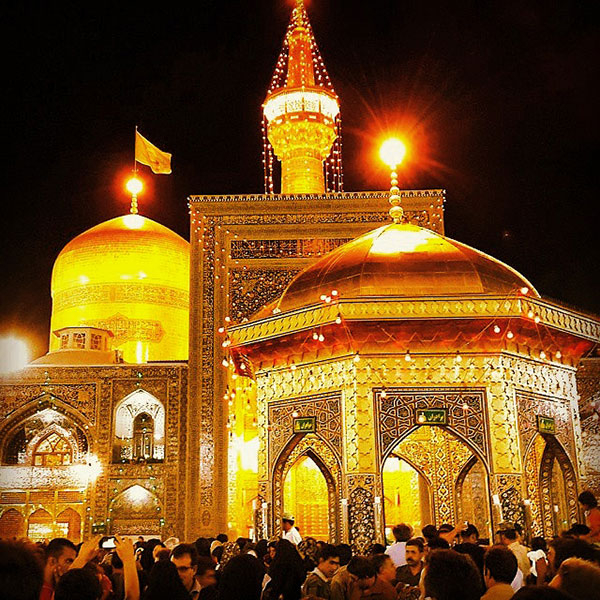Najaf Al Ashraf
The holy and divine shrine of the first Imam of Shiites, Imam Ali (AS), is located in Najaf. Najaf is a city in central Iraq about 160 km (roughly 100 miles) south of Baghdad. Its estimated population in 2013 was 1,000,000 people. It is widely considered the third holiest city of Shi'a Islam. According to terminologists, “Najaf” means a high, round piece of ground which is like a hill located on a plain land and water does not overtake it and it is dominant over other lands. Najaf, today, is located behind the old Kufa which is also called Najaf of Hira and Najaf of Kufa.
This narration tells why Najaf is being called Najaf:
Abi Naim quotes Imam Sadiq (AS) who said:
Najaf is that mount where son of Prophet Noah said ‘I will go over that to escape being drowned in the flood’. There was no higher piece of ground on the whole earth. God, the Almighty, addressed the mount ‘You, Mount! Shall one seek refuge from me to you?’ So, quickly, the mount fragmented into pieces of small stones and pieces were thrown to sides and turned into a huge see and afterwards was called “the Sea of Nei”. Then it dried and was called “Nei Jaf”. Little by little, due to difficulty in pronunciation, people called this land as Najaf.
Al-saduq , Abu Ja 'far Muhammad ibn Ali ibn Hussein ( died 381 A.H ) , Elal Al-sharayeh , vol. 1 , p 31 , Publisher : Dawari , Qom , First Edition .
The Prophet’s Prediction about Imam Ali’s Tomb
Ibne Tawous says “I read it in Hassan Ibne Hussein Ibne Tahal’s book that Ibne Ibne Abbas quoted the Holy Prophet who said to Imam Ali (AS) that ‘You will be buried in Kufa’”.
The Holy Prophet told Imam Ali (AS) “You, Ali! Lord of the existence granted our love to whole heavens and earth. The first to accept it was the sevenths sky, so God honored it with throne. Then the fourth sky accepted, so it was honor with Beit Al Mamur (a castle in the fourth sky). Then the worldly sky accepted, so it was honored with stars. Then the land of Hijaz accepted, so it was honored with Kaba, the great house. Then the land of Sham accepted, so it was honored with Beit Al Muqaddas. Then the land of Medina accepted, so it was honored with my tomb. Then the land of Kufa accepted, so it was honored with your (Imam Ali) tomb”. Then Imam Ali asked “Will I be buried in Kufa in Iraq?” The Prophet replied “Yes! You will be martyred and will be buried in a desert behind the mount Qarreyn (which was discussed earlier). And the most wicked and miserable of these people will kill you, who is Abdul Rahman Ibne Muljam. I swear to the God who sent me to guide these people that this man is more cursed and will be more tormented than the one who bothered the camel of Prophet Salih. You, Ali! You will be helped by one hundred thousand warriors from Iraq”.
Seyyed Ibne Tawous says in the end:
This hadith is true and it is enough to prove what is being claimed.
Al-Hasani , Sayyid Abd al-Karim ibn Tawous , ( died 693 A.H ) , Faraha al-Qara Faye Tahiin grave of Amir al-Moaminin Ali (AS) , page 56 , Research : al-sayyed Tahsin Al Shabib Al-Musawi , al-Nasher : Center of Ghadir Lelderasat al-Islamic , first edition ,1419 AH - 1998 AD
For many years his grave was hidden. Ibne Abi Al Hadid thinks that Imam Ali’s children made this decision not to reveal the location of his tomb:
When Ali (AS) was killed, his children hid his tomb from the public, because they feared Bani Umayye would disrespect his body…
Ibn Abi al-Hadid al-Madaeni al-Mohtazeli , Abu Hamed Izz al-Din ibn Hobullah ibn Muhammad ibn Muhammad ( died 655 A.H ) , Sharh Nahjol – Balaghah , vol. 4 , p. 49 , research by Muhammad Abdul karim al-Nimri , publisher : Dar al-kotob al-Elmyah , Beirut – Lebanon , first edition , 1418 A.H , 1998 A.D .
Anyway, whether it was Imam’s own will or it was his son’s decision, the point is it was because of Bani Umayye’s enmity and the head of them at that era was Muawiye.
Muawiye did somethings that peoves if he could reach Imam’s tomb, he would certainly disrespect it.
Promotion of Cursing Imam Ali (AS)
Muslim Neishabouri writes in his Sahih:
Amer Ibne Sad Ibne Abi Waqqas quotes his father who said “One day Muawiye Ibne Abi Sufyan ordered me [to curse Ali Ibne Abi Talib. I disobeyed him]. Muawiye asked me about the reason of disobedience. I said ‘I heard three virtues about Ali Ibne Abi Talib from the Holy Prophet. Because of that, I will never curse him or oppose him. Each of those virtues, for me, might be much pleasing and better than herds of red camels’”.
Sahih Moslim , vol. 4 , p. 1871 , H – 2404 , Book Fazael al-Sahabah , chapter of the virtues of Ali Ibn Abi Talib .
According to some sources, Muawiye had some plans for exhumation of Imam Ali’s tomb. He even consulted two of his advisors in this regard. One of them was Marwan Ibne Hakam.
Qazi Abi Hanife Naman Maqribi writes about Marwan:
Ali (AS) arrested Marwan in the war of Jamal. He forgave him and freed him. But he was ignorant to that. He consulted with Muawiye about exhumation of Ali’s tomb when he gained power. He even motivated Muawiye to do so. He reminded Muawiye how members of Bani Abd Al Shams Tribe were killed in the war of Badr and they were not buried, like pagans.
Al-Tamimi al-Maqrebi , al-Qazi Abi Hanifa al-Nehman ibn Muhammad (died 363 A.H), Sharh al-Akhbar fi Fazael Imams al-Atar , vol. 3 , p. 162 , research by al-Sayed Muhammad al-Husseini al-Jalali , publisher ; institute of al-Nashr al-Islami al-Tabeha Lejamaha al-Modarresin – Qom , second edition , 1414 A.H.
Then Muawiye consulted Abdullah Ibne Amer about this matter, but he denied this matter and banned Muawiye from doing so:
Muawiye consulted Abdullah Ibne Amer about exhumation of Ali’s tomb. He said “I do not like to know where Ali’s tomb is located; neither I like to ask for it. I do not want our people have such an end”. Muawiye accepted what he said and rejected Marwan’s decision for exhumation.
Al-Tamimi al-Maqrebi , al-Qazi Abi Hanifa al-Nehman ibn Muhammad (died 363 A.H), Sharh al-Akhbar fi Fazael Imams al-Atar , vol. 3 , p. 162 , research by al-Sayed Muhammad al-Husseini al-Jalali , publisher ; institute of al-Nashr al-Islami al-Tabeha Lejamaha al-Modarresin – Qom , second edition , 1414 A.H.
Imam Sadeq (AS) informed some of his companions of the place of Imam Ali’s tomb which was located somewhere behind Kufa, somewhere which is well-known now. These companions and followers include Abu Basir, Abdullah Ibne Talhe, Mualli Ibne Khunais, Yunis Ibne Zibiyan, and some others. Before Imam Sadeq (AS), Imam Sajjad (AS) used to come to Kufa for visiting Imam Ali’s tomb by his servant. But not all of people were informed about the tomb. After Imam Sadeq (AS), Haroun Al Rashid, the fifth Khalifa of the Abbasid Dynasty, revealed the tomb in the year 170 (after hijrat) and, as the result, people understood where it is located.
Al-Amin , al-sayed Mohsen , ( died 1371 ) , Ahyan al-shiite , vol. 1 , p 535 , Research and Takhrij : Hassan al-Amin , Publisher : Dar al-Taharof Lelmatboat , Beirut , Lebanon .
According to different narrations, the holy tomb of Imam Ali (AS) was revealed to all in two steps. The first step was at the time of Imam Sadeq (AS) and the second during the reign of Haroun Al Rashid, the Abbasid Khalifa.
We should be aware that the gap between Imam Sadeq’s martyrdom and Haroun’s coming to power was about twenty two years. It is natural that in such a time, if no one could visit that place, it would be forgotten and even if there was a wall or building around there, it could have been destroyed.
By appearance, we mean Imam Ali’s lovers and followers could freely and without any fear go and visit his tomb and they had no stress about that. Otherwise, the holy shrine was known to Ahle Bait and their loyal followers, but they could not visit this place freely and publically but during these two periods.
Building a dome and shrine over the tomb of Imam Ali (AS) has passed several steps during several ages.
Before this, we mentioned that it was after Imam Sadeq (AS) that Haroun, as the second time, found the tomb of Imam Ali (AS) and revealed it to all.
The first building over Imam Ali’s tomb was made by Haroun Al Rashid in 170 after hijrat. This that some books mentioned the year as 155 is false. That is because Rashid came to power in 170 and passed away in 193. Appearance of the tomb and building a monument happened during his reign.
Al-Amin , al-sayed Mohsen , ( died 1371 ) , Ahyan al-shiite , vol. 1 , p 536 , Research and Takhrij : Hassan al-Amin , Publisher : Dar al-Taharof Lelmatboat , Beirut , Lebanon .
In many hadiths by the infallible imams, we read that Prophets Adam and Nuh’s (pbuh) burial sites are in Najaf. The following are some of those hadith:
1- Abu Basir says that he asked Imam Sadiq (as) where Imam Ali (as) was buried. The Imam replied: At the grave of his father Nuh. Abu Basir asked where Prophet Nuh’s (pbuh) grave was and that the people say it is in the masjid of Kufa. The imam said: “No it is located behind Kufa.”[ Wasa’elul-Shia, vol. 14, pg. 386, hadith 19436]
2- Imam Sadiq (as) said: “…Whenever you do the ziyarat of Imam Ali (as), know that you have also done the ziyarat of Prophets Adam and Nuh (pbuh)…” Tusi, Tahdhibul-Ahkam, vol. 6, pg. 23, hadith 8.
It is clearly concluded from these and the many other hadiths on the issue that the graves of Prophets Adam and Nuh (pbuh) are located in present Najaf (behind Kufa), and since at that time Najaf wasn’t a city and was a barren desert located behind Kufa, it was referred to as “behind Kufa” or “near Kufa”.


















